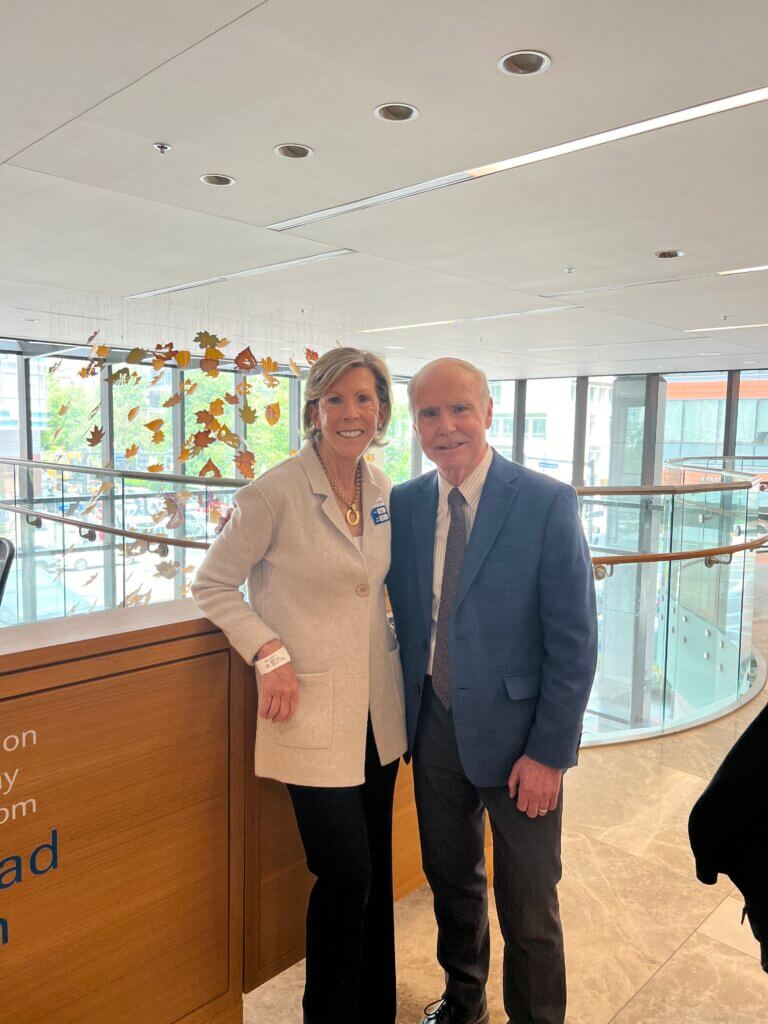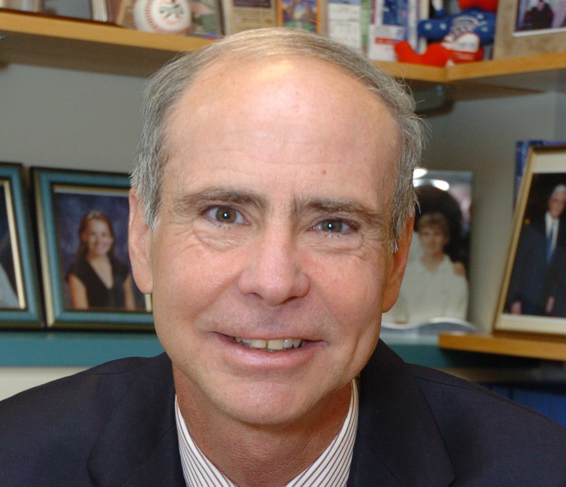Kathy Giusti was driving in rush hour traffic one January day in 1996 when her doctor called and requested they meet the next morning about her recent blood tests. Alarmed, Giusti insisted on more details, and the doctor eventually shared his concerns that she may have multiple myeloma.
Giusti’s response to this news was quick and to the point: “What is that?”
Despite her experience as an executive in the pharmaceutical industry, Giusti, then 37, had never heard of multiple myeloma — an aggressive and incurable cancer of the bone marrow. And once her diagnosis was confirmed, and she learned more about the disease, her concern turned to frustration over the lack of treatment options or promising research. Giusti was married with a one-year-old daughter, and she and her husband, Paul, were hoping to grow their family. Now, her doctors told her, she was suddenly facing a life expectancy of three years.

Rather than accept these odds at face value, Giusti committed herself to increasing them — for herself and for others. In 1998 she and her identical twin sister, Karen Andrews, founded the Multiple Myeloma Research Foundation (MMRF), which has since assisted thousands of patients in their treatment journeys while using education, investment, and advocacy to help in the development of 15 drugs approved by the U.S. Food and Drug Administration for multiple myeloma care. Among the clinicians and scientists partnering closely with the MMRF is Giusti’s own longtime oncologist, Kenneth C. Anderson, MD, program director of the Jerome Lipper Multiple Myeloma Center at Dana-Farber.
Giusti has used her business acumen and personal experiences as a survivor to push for more innovative, affordable research approaches and clinical trials led by world-renowned experts including Anderson. She was an early advocate for precision (or personalized) medicine, using an individual’s unique genetic makeup — and in the case of cancer treatment, that of their tumors — to create targeted therapies that attack tumor cells with specific abnormalities while leaving normal (noncancerous) cells alone.
Due in large part to the MMRF’s efforts, average life expectancy for multiple myeloma patients has increased from three to 10 years. There is also more understanding than ever about precursor conditions for the disease such as MGUS and smoldering myeloma, both of which are being studied at Dana-Farber’s Center for Early Detection and Interception of Blood Cancers.
“Ken [Anderson] and I really have two relationships, one as doctor to patient, and one through the MMRF,” says Giusti. “We are committed to finding a personal cure for me, but also to finding a cure period. Multiple myeloma has gone from a disease with limited treatment options to one of the most treatable cancers out there, and I think a lot of that is due to our ability to work so well together.”
Whiteboards and warmth
Giusti’s path to becoming a patient, as well as a patient champion, began in December 1995. She felt uncharacteristically rundown and was losing weight, both of which she would later learn are warning signs for multiple myeloma. When she underwent blood work in preparation for fertility treatments — she and Paul were struggling to conceive a second child — the tests revealed her blood was low in hemoglobin and hematocrit but high in protein. This prompted her doctor’s rush hour call.
Before meeting with him, she and Paul stopped at a bookstore to study up on blood and bone marrow cancers. They didn’t find much in that first harried search, and Giusti spent the next several weeks making phone calls that would eventually lead her to Dana-Farber and Anderson.

Giusti was drawn to Anderson not only by his calm, warm approach to care — which she says is a great complement to her frenetic, type-A personality — but also by the whiteboard in his office. It was routinely filled with details on the most promising new multiple myeloma drugs, a physical manifestation of Dana-Farber’s equal dedication to scientific discovery and patient care. This 50-50 balance, Giusti knows from experience, is unique among cancer centers.
“As a patient who did tons of my own research, I wanted to be with clinicians who were more on top of the disease than I ever could be,” says Giusti. “That was Ken and the team around him. Because he is not only a great clinician, but also a great translational researcher, the best drugs and trials are always coming his way.”
Living in Chicago at the time of her diagnosis, Giusti relocated to her native New England to be closer to both family and Dana-Farber. And while she has faced many challenges in nearly 30 years of treatment, including a stem cell transplant and a 2022 breast cancer diagnosis, she has always been buoyed by the support and care she’s received from Anderson and others at the Jerome Lipper Multiple Myeloma Center.
“There is a very strong sense of collaboration at Dana-Farber, with clinicians working together in a beautiful environment,” says Giusti. “They are taking care of the patient of today, but also making sure they are focused on the cure for tomorrow.”
By the book
In addition to starting the MMRF, something else happened early in Giusti’s treatment. She began compiling the first of what would eventually be 28 notebooks detailing her multiple myeloma journey — each step and misstep along the way. The journals would form the basis for her new book, Fatal to Fearless: 12 Steps to Beating Cancer in a Broken Health-Care System. In it, Giusti shares her own story and provides advice for others. Among the insights she’s gained:
- Research Wisely: Learn all you can about your exact type and stage of cancer, and make sure to only search reputable sites online — starting with cancer.gov, cancer.org, and cancer.edu, and those of nationally recognized foundations (like the MMRF) and NCI-designated comprehensive cancer centers (like Dana-Farber Cancer Institute) targeting your specific disease.
- Get a Second Opinion: You should always do this, and it should be covered by insurance.
- Line Up the Right Team: This applies to your medical team as well as caregivers drawn from your family and friends. Assemble a sounding board of people who will be honest and open in helping you make decisions, and support you each step of the way.
- Keep Up on Clinical Trials: Know where to find the latest, most promising trials focused on your cancer. Meeting roundups from organizations like the American Society of Cancer Oncologists (ASCO), which you can find online, are a great place to start, and NCI-designated cancer centers have access to more new trials than other hospitals.
- Rethink What Matters: Write down your wants and needs after diagnosis, and say them out loud. For me, needs included where we were going to live and who was going to take care of our daughter. Wants included having another child. For someone else it might be traveling the world or seeking a promotion at work.

Giusti has recently reached 30 years of survivorship, during which she and Paul have raised their daughter Nicole and son David into adulthood. And while she has transitioned from her role as president and CEO of the MMRF for two decades to a board position with the foundation, she continues consulting with patients, researchers, and clinicians like Anderson.
About the Medical Reviewer

Dr. Anderson is the Kraft Family Professor of Medicine at Harvard Medical School as well as Director of the LeBow Institute for Myeloma Therapeutics and Jerome Lipper Multiple Myeloma Center at Dana-Farber Cancer Institute. He is a Doris Duke Distinguished Clinical Research Scientist and American Cancer Society Clinical Research Professor. After graduating from Johns Hopkins Medical School, he trained in internal medicine at Johns Hopkins Hospital, and then completed hematology, medical oncology, and tumor immunology training at the Dana-Farber Cancer Institute. Over the last four decades, he has focused his laboratory and clinical research studies on multiple myeloma. He has developed laboratory and animal models of the tumor in its microenvironment which have allowed for both identification of novel targets and validation of novel targeted therapies, and has then rapidly translated these studies to clinical trials culminating in FDA approval of novel targeted and immune therapies. His paradigm for identifying and validating targets in the tumor cell and its milieu has transformed myeloma therapy and markedly improved patient outcome.
